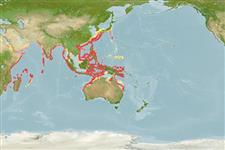Common names from other countries
>
Carangiformes (Jacks) >
Carangidae (Jacks and pompanos) > Caranginae
Etymology: Decapterus: Greek, deka = ten + Greek, pteron = wing, fin (Ref. 45335).
More on author: Bleeker.
Environment: milieu / climate zone / depth range / distribution range
Écologie
marin récifal; profondeur 100 - 300 m (Ref. 3197), usually 150 - 300 m (Ref. 3197). Deep-water; 38°N - 26°S, 34°E - 148°E
Indo-West Pacific: East Africa to the Philippines, north to southern Japan, south to Western Australia.
Length at first maturity / Taille / Poids / Âge
Maturity: Lm 17.2 range ? - ? cm
Max length : 45.0 cm TL mâle / non sexé; (Ref. 3197); common length : 30.0 cm FL mâle / non sexé; (Ref. 3287)
Épines dorsales (Total): 9; Rayons mous dorsaux (Total): 28-29; Épines anales 3; Rayons mous anaux: 22 - 25. Deep bodied compared to similar species (Ref. 48635). Body color bluish green above, silvery below; caudal fin bright red. Sometimes a yellow mid-lateral stripe (Ref. 48635). Opercle with a small black spot; margin of opercular membrane smooth. 31-38 scutes.
Adults are found in deep waters. They feed on small planktonic invertebrates (Ref. 5213). Occasionally seen in small groups along reef slopes at moderate depths. Mainly known from trawls and shows red tail after capture (Ref. 48635).
Paxton, J.R., D.F. Hoese, G.R. Allen and J.E. Hanley, 1989. Pisces. Petromyzontidae to Carangidae. Zoological Catalogue of Australia, Vol. 7. Australian Government Publishing Service, Canberra, 665 p. (Ref. 7300)
Statut dans la liste rouge de l'IUCN (Ref. 130435)
CITES (Ref. 128078)
Not Evaluated
Menace pour l'homme
Harmless
Utilisations par l'homme
Pêcheries: commercial
Plus d'informations
RéférencesAquacultureProfil d'aquacultureSouchesGénétiqueElectrophoresesHéritabilitéPathologiesTraitementMass conversion
Outils
Articles particuliers
Télécharger en XML
Sources Internet
Estimates based on models
Preferred temperature (Ref.
115969): 11.5 - 22.4, mean 15 (based on 274 cells).
Phylogenetic diversity index (Ref.
82804): PD
50 = 0.5010 [Uniqueness, from 0.5 = low to 2.0 = high].
Bayesian length-weight: a=0.01413 (0.00931 - 0.02143), b=2.98 (2.85 - 3.11), in cm Total Length, based on LWR estimates for this species & Genus-body shape (Ref.
93245).
Niveau trophique (Ref.
69278): 3.4 ±0.45 se; based on food items.
Résilience (Ref.
120179): Milieu, temps minimum de doublement de population : 1,4 à 4,4 années (K=0.63).
Fishing Vulnerability (Ref.
59153): Low vulnerability (25 of 100).
